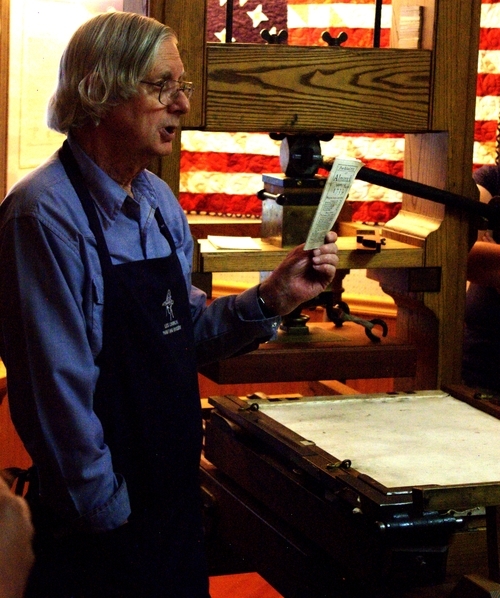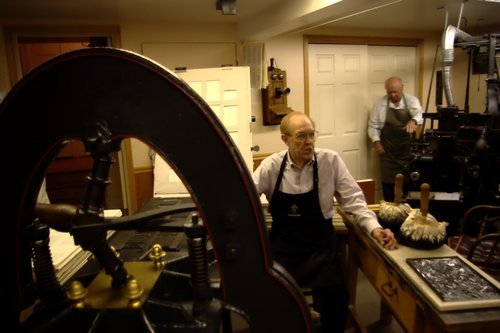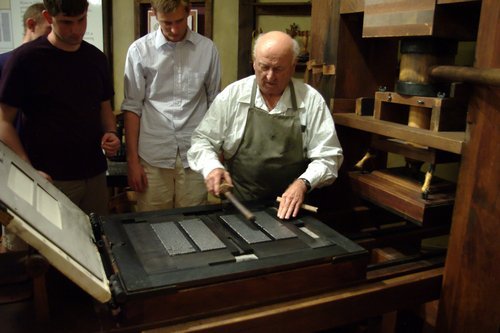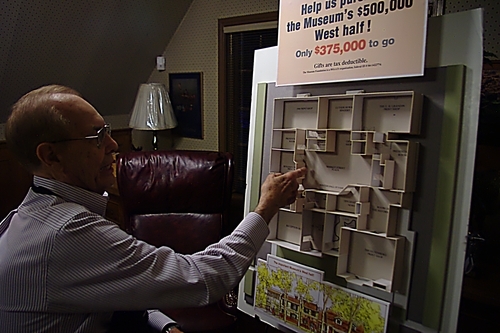This is an archived article that was published on sltrib.com in 2011, and information in the article may be outdated. It is provided only for personal research purposes and may not be reprinted.
Provo • Louis Crandall believes in the power of the press.
After all, Johannes Gutenberg and his Bible printed with movable type helped propel the Renaissance and the Reformation.
Benjamin Franklin and other publishers spurred a revolution, spreading the ideals of life, liberty and the pursuit of happiness, and made Thomas Paine's Common Sense a common pamphlet in colonial America.
And, for Latter-day Saints, Egbert Grandin helped give rise to a restored religion by printing the first 5,000 copies of the faith's signature scripture, The Book of Mormon.
From Gutenberg to Grandin, the miracle of the written word is all spelled out at the Crandall Historical Printing Museum in downtown Provo.
"Without printing, there would be no America," explains Crandall, the museum's founder, president and chief executive.
In fact, Crandall sees his museum as a miracle, too, starting with his loan of a printing press to The Church of Jesus Christ of Latter-day Saints.
"I didn't build it," Crandall tells a group touring the 15-year-old museum one summer evening. "The Lord built it."
And now, in this digital age, Crandall is praying for another miracle — and help from some down-to-earth angels — to bring to full fruition his vision of the museum dedicated to printing's role in religious and U.S. history.
Crandall is trying to raise money to reclaim the office building next door to the colonial-looking house that is home to both Crandall and his museum.
The office building was originally owned by Sutherland Institute founder Gaylord Swim, who intended to donate it to Crandall.
Brent Ashworth, a document collector and a member of the museum's board of trustees, says the donation fell through after Swim's death in 2005.
Instead, the museum bought the building and Crandall worked on plans to expand into it, providing more room for tours and exhibits. But earlier this year, the bank foreclosed after the museum fell behind on payments.
Now, although Far West Bank owns the building, Crandall sees a chance to buy it back — if he can raise the cash. The asking price: $322,500.
Ashworth, who is helping with the fundraising, says obtaining the building would allow Crandall to host larger tour groups and better showcase the history of printing.
"We came from the Dark Ages to the Renaissance," Ashworth says, "because of the printing press."
Crandall's establishment isn't a typical museum. It looks, sounds and smells like a print shop.
The aroma of hot metal — made from the same recipe used to cast movable type for half a millennium — wafts through the air. Presses creak as docents — and guests — pull on the handles.
Crandall and docents Wallie Saling, Jim Watkins and Larry Erickson demonstrate how pages were printed in various historical eras, using replicas of presses once used by Gutenberg, Franklin and Grandin.
Each room boasts equipment from those eras, including replicas of the actual type used to print Gutenberg's Bible, the Declaration of Independence and the first edition of The Book of Mormon.
But the museum is cramped. Only half of Crandall's treasures are on display, and groups must crowd shoulder-to-shoulder in a small room to watch Crandall or Saling demonstrate Franklin's printing press.
An expanded building would provide more breathing room and allow Crandall to fulfill another goal: Make the museum a stop for Mormon missionaries at the LDS Missionary Training Center in Provo.
He believes the missionaries would better teach Mormon beliefs if they knew what it took to make the scriptures available to the masses.
Crandall's love of printing dates back almost 70 years, to when the then-14-year-old was hired to set type at Strauch's Print Shop in Mesa, Ariz.
Even today, the 81-year-old Crandall can still quickly set a line of type and return each letter to the case even more quickly.
Crandall graduated from Arizona State University and opened a printing and graphic arts business. He also started Legend City in 1963, a Disneyland-like Wild West theme park near Phoenix.
In 1964, Crandall and his first wife, Mabel, came to Provo at the city's request to start a ski resort. That venture fell through, but the Crandalls launched an advertising agency. Among their clients were KLM Airlines, Marriott Courtyard hotels and the Osmonds.
But printer's ink still coursed through Crandall's veins.
He had purchased his first printing press for $700, a wooden Washington Hand Press, similar to the one LDS leaders used in the 1830s to print the Book of Commandments, a predecessor to the faith's Doctrine and Covenants.
Crandall kept it in the back of his office and would use it to tell visitors how The Book of Mormon was printed.
Then came a phone call in 1987 from LDS general authority Loren C. Dunn that set in motion the Crandall museum. Dunn had a proposition for Crandall: Would he sell his printing press to the church, which desired it for a restored print shop in Nauvoo, Ill.?
"I told him, 'Elder Dunn, next to Mabel, my printing press is my most prized possession,' " Crandall recalls. "Then Elder Dunn said, 'I could call you and Mabel on a mission to Nauvoo and have you bring your press.' "
Instead, the church agreed to borrow the press for three years, displaying it in the Times and Seasons office on Main Street.
When it was returned to Crandall three years later, the movers dropped the press and damaged it.
Crandall views that accident as a blessing.
The church had the press repaired by Steve Pratt, a wagon builder from Cove Fort. The mended press was better than before, Crandall says, and led to a partnership with Pratt, who made replicas of the Gutenberg and Franklin presses.
The printing museum was born.
"Had Elder Dunn not made that phone call," Crandall says, "Steve Pratt would never have gotten into the printing business."
Pratt also made two replicas of Grandin's printing press, one for the restored Grandin Print Shop in Palmyra, N.Y., and one for Crandall's museum.
Even if his pursuit of the office building falls short, Crandall vows to continue his museum in its current, cramped quarters as a testament to type.
After all, he says, the story has to be told.
Twitter: @donaldwmeyers
facebook.com/donaldwmeyers —
If you go
P For more about the Crandall Historical Printing Museum, 275 E. Center St., Provo, go to crandallmuseum.org.











